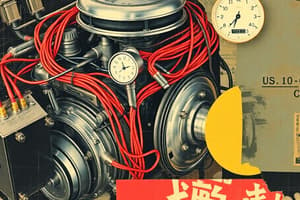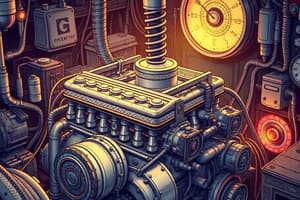Podcast
Questions and Answers
What should you do whenever you change an engine’s oil?
What should you do whenever you change an engine’s oil?
Do a visual inspection of the different systems under the hood.
What should you check for in the cooling system hoses?
What should you check for in the cooling system hoses?
- Sound
- Size
- Color
- Leakage (correct)
What should be done if the radiator shows signs of leaks?
What should be done if the radiator shows signs of leaks?
The radiator should be repaired or replaced.
The level and condition of the engine’s _____ should be checked.
The level and condition of the engine’s _____ should be checked.
What color should the coolant generally be?
What color should the coolant generally be?
What device is used to check the amount of antifreeze in the coolant?
What device is used to check the amount of antifreeze in the coolant?
Which components are typically driven by V-belts or V-ribbed belts?
Which components are typically driven by V-belts or V-ribbed belts?
Flashcards
Minor Engine Electrical Service
Minor Engine Electrical Service
A task involving minor adjustments and repairs to the engine's electrical components, including replacing system assemblies.
Coolant Level Check
Coolant Level Check
A process that ensures the coolant is within the appropriate 'low' to 'full' range in the coolant recovery tank.
Coolant Condition
Coolant Condition
Assessing the coolant's color and consistency to identify potential contamination (e.g., rusty or cloudy).
Coolant Hydrometer
Coolant Hydrometer
Signup and view all the flashcards
Drive Belts
Drive Belts
Signup and view all the flashcards
Cooling System Hoses
Cooling System Hoses
Signup and view all the flashcards
Radiator Inspection
Radiator Inspection
Signup and view all the flashcards
System Component Assembly
System Component Assembly
Signup and view all the flashcards
Post-Service/Pre-Delivery Check
Post-Service/Pre-Delivery Check
Signup and view all the flashcards
Minor Adjustments
Minor Adjustments
Signup and view all the flashcards
Study Notes
Automotive Mechanics NTQF Level II, Learning Guide #3
- Unit of Competence: Perform minor engine electrical systems service
- Module Title: Performing minor engine electrical systems service
- LG Code: EIS AUM2 M02 LO3-01
- TTLM Code: EIS AUM2 M04 0322
- Unit 3: Replace/Reassemble System Assemblies
Instruction Sheet LG3: Replace/Reassemble System Assemblies
- Topic: Replace/Reassemble System Assemblies
- Carry out minor adjustments: Includes checking cooling system hoses for leaks or damage, inspecting radiator for leaks/dirt buildup, and checking coolant level
- Assembling system components: This involves putting components back together.
- Conducting post-service/pre-delivery check: Includes reviewing systems, confirming components were installed/replaced correctly, and ensuring that the vehicle meets the specifications
- Learning Activities: Read objectives, review 'Information Sheets' (pages 2), complete 'Self-check 3' (page 71), and receive feedback from instructor on work quality.
Replace/Reassemble System Assemblies, Unit Three
-
Carrying out minor adjustments:
- Inspect cooling system hoses for leaks
- Check radiator for leaks and buildup of dirt/debris
- Verify coolant level (should be between low and full marks)
- Use correct coolant type
- Flush coolant system if it's contaminated
-
Coolant Condition:
- Use coolant hydrometer to check antifreeze percentage
- Check coolant color (should be green or orange, not rusty or cloudy)
-
Drive Belts:
- V-belts and V-ribbed belts used for various functions
- Drive belts wear over time and may cause slippage
- Inspection needed to check for damage: wear, glazing, tears, splits, or oil soaking
- Pulleys should be inspected for rust, oil, or damage and aligned properly
-
Belt Tension:
- Inspect belt tension regularly (midway through the largest span)
- Excessive belt tension issues can damage the associated components.
-
Using service information: Consult service manuals for correct belt tightening procedures and specifications.
Assembling System Components
- System Components: Connect the injector nozzle, cooling system, exhaust, and fuel pipes correctly.
- Thermostat: Connect fuel pipe and electrical lead.
- Additional Connections: Connect air filter, induction/exhaust manifold and cooling system properly.
Conducting Post-Service/Pre-Delivery Check
- Documentation: Use documentation to record organization's development & acquisition of operating environments & systems.
- Technician Access: Provide technicians with operation manuals for effective maintenance.
- Automated Documentation: Utilize software to improve maintainability & accuracy
Final Inspection
- Consumer Expectations: Consumers expect vehicles to be in excellent working order upon return.
- Inspection Criteria: Ensure that all safety components are correctly positioned and working properly and meets expected specifications.
- Documentation: Maintain records of all service work and any necessary repairs
Completing and Delivering Report/Final Procedures
- Report Delivery: Technicians deliver completed reports to the appropriate personnel.
- Documentation Procedures: Use standardized records, concise summaries, flow diagrams, and checklist items for maintenance and transparency.
Studying That Suits You
Use AI to generate personalized quizzes and flashcards to suit your learning preferences.




